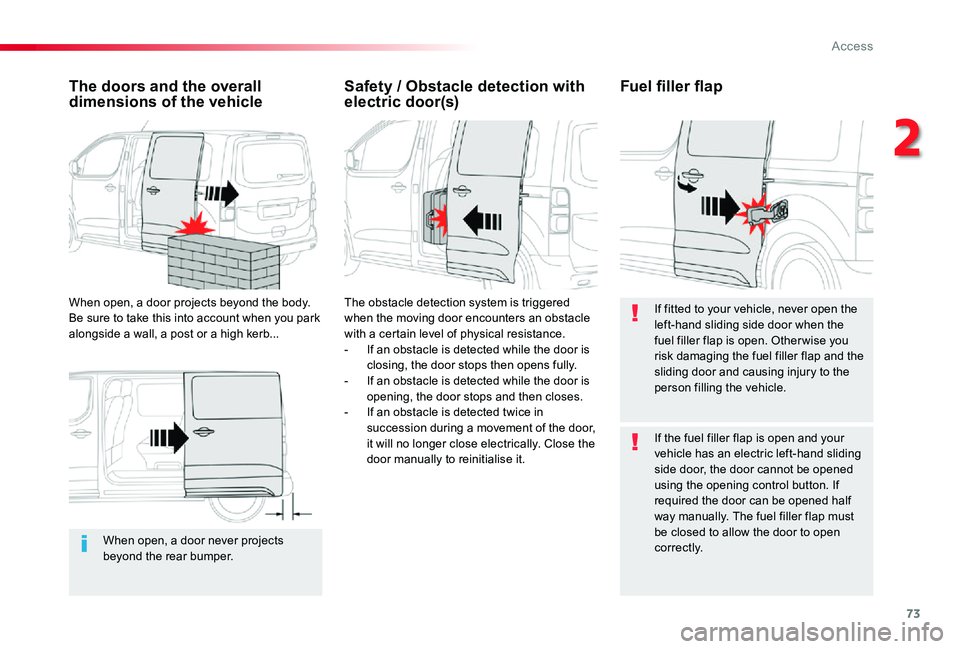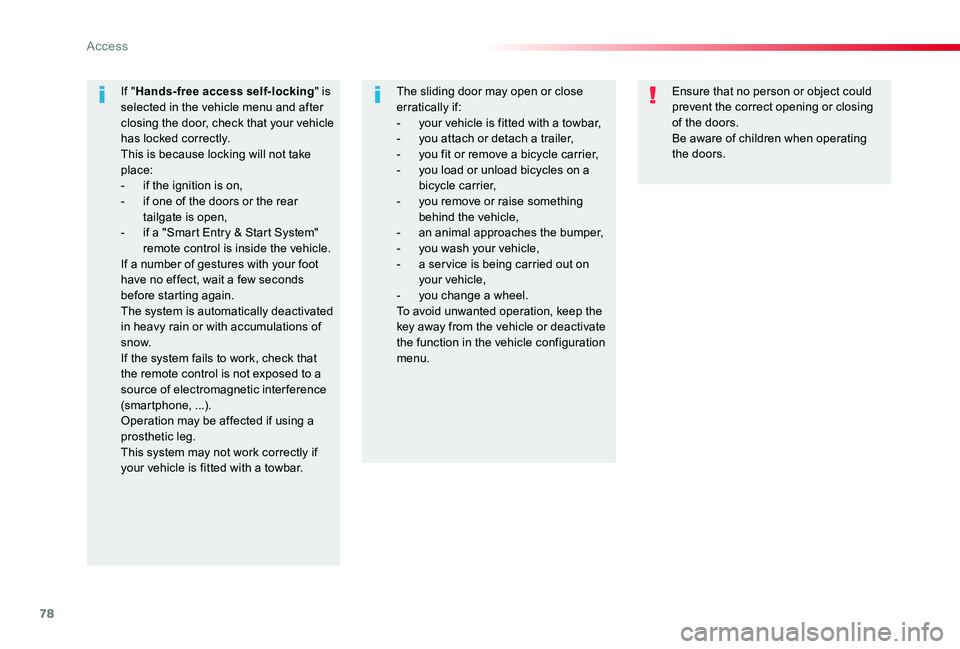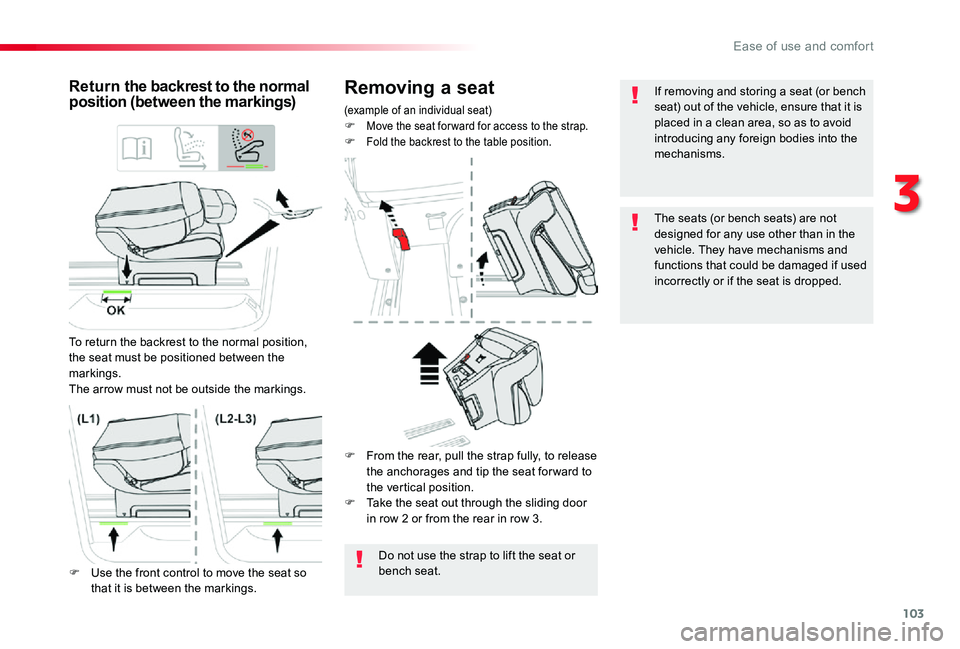Page 72 of 418

72
General recommendationsBefore any opening or closing and during any movement of the doors, ensure that no person, animal or object is protruding through the window frame or might prevent the intended manoeuvre, either inside or outside the vehicle.If this advice is not followed, injuries or damage may occur if a person or an object is trapped or caught.Electric closing and opening of the doors is not possible above 2 mph (3 km/h):- If you set off with the door(s) open, you must slow down to below 2 mph (3 km/h) in order to close the d o o r (s).- Any attempt to open a door electrically using the interior handle while driving, results in only being
possible to open the door manually.- This situation is accompanied by the audible warning, illumination of the "door open" warning lamp and the message in the multifunction screen. To release the door and be able to operate it again, it is necessary to stop the vehicle.
Manual or electric sliding side door(s)
The electric controls are inhibited in the event of an impact. Manual opening and closing remain possible.
While starting the engine, the movement of a door is interrupted and restored once the engine is running.
Depending on the engine, in Stop mode of Stop & Start, if the door is closed and you initiate opening of the door, the door opens partially and stops. When the engine changes automatically to Start mode, the door continues its movement.
The doors must only be operated when the vehicle is stationary.For your safety and for that of your passengers, as well as for correct operation of the doors, you are strongly advised not to drive with a door open.Always check that it is safe to operate the door and in particular, be sure not to leave children or animals near the door controls without super vision.The audible warning, illumination of the "door open" warning lamp and the message in the multifunction screen are there to remind you. Contact an authorized Toyota dealer or repairer, or another duly qualified and equipped
professional to deactivate these warnings.Lock your vehicle when using an automatic car wash.
Access
Page 73 of 418

73
When open, a door never projects beyond the rear bumper.
The doors and the overall dimensions of the vehicle
When open, a door projects beyond the body. Be sure to take this into account when you park alongside a wall, a post or a high kerb...
Safety / Obstacle detection with electric door(s)Fuel filler flap
The obstacle detection system is triggered when the moving door encounters an obstacle with a certain level of physical resistance.- If an obstacle is detected while the door is closing, the door stops then opens fully.- If an obstacle is detected while the door is opening, the door stops and then closes.- If an obstacle is detected twice in succession during a movement of the door, it will no longer close electrically. Close the
door manually to reinitialise it.
If fitted to your vehicle, never open the left-hand sliding side door when the fuel filler flap is open. Other wise you risk damaging the fuel filler flap and the sliding door and causing injury to the person filling the vehicle.
If the fuel filler flap is open and your
vehicle has an electric left-hand sliding side door, the door cannot be opened using the opening control button. If required the door can be opened half way manually. The fuel filler flap must be closed to allow the door to open c o r r e c t l y.
2
Access
Page 75 of 418

75
The automatic locking after closing the door is programmable in the vehicle configuration menu.
Kick-activated side doors opening and locking
By keeping the remote control on your person and with a movement of your foot, the system unlocks and opens the sliding side door or closes and locks it.The remote control must be located at the rear of the vehicle, more than about 30 cm and less than about 2 m from the vehicle.
Before making the movement with your foot, ensure that you are steady and well positioned, so that you do not lose your balance (rain, snow, ice, mud, ...).Take care not to touch the exhaust tailpipe when making the movement with your foot - risk of burns.
Make the movement without interruption and do not repeat it immediately after wards or several times.If the door does not open, wait about 2 seconds before trying again.Do not leave your foot in the air.
F Pass your foot below the rear bumper then remove it, as though kicking (upwards).The sensor detects your foot approaching and leaving and triggers opening or closing of the side door.
2
Access
Page 77 of 418
77
Deactivation
By default, hands-free access is activated.The function can be deactivated in the vehicle configuration menu.
Automatic locking
The vehicle locks itself following the Kick-activated closing of a sliding door.The automatic locking can be deactivated in the vehicle configuration menu.
If your vehicle is not fitted with an alarm, locking is confirmed by fixed illumination of the direction indicators for about two seconds.Depending on version, the door mirrors
fold at the same time.
Operating fault
An audible signal repeated three times indicates a fault with the system.
Contact an authorized Toyota dealer or repairer, or another duly qualified and equipped professional to have the system checked.
With audio system or touch screen
The "Hands-Free Tailgate Access" function or automatic vehicle locking when the sliding door is closed is activated and deactivated via the vehicle configuration menu.
2
Access
Page 78 of 418

78
Ensure that no person or object could prevent the correct opening or closing of the doors.Be aware of children when operating the doors.
If "Hands-free access self-locking" is selected in the vehicle menu and after closing the door, check that your vehicle has locked correctly.This is because locking will not take place:- if the ignition is on,- if one of the doors or the rear tailgate is open,- if a "Smart Entry & Start System" remote control is inside the vehicle.If a number of gestures with your foot have no effect, wait a few seconds before starting again.The system is automatically deactivated in heavy rain or with accumulations of snow.If the system fails to work, check that the remote control is not exposed to a source of electromagnetic interference (smar tphone, ...).Operation may be affected if using a prosthetic leg.
This system may not work correctly if your vehicle is fitted with a towbar.
The sliding door may open or close erratically if:- your vehicle is fitted with a towbar,- you attach or detach a trailer,- you fit or remove a bicycle carrier,- you load or unload bicycles on a bicycle carrier,- you remove or raise something behind the vehicle,- an animal approaches the bumper,- you wash your vehicle,- a ser vice is being carried out on your vehicle,- you change a wheel.To avoid unwanted operation, keep the key away from the vehicle or deactivate the function in the vehicle configuration menu.
Access
Page 99 of 418
99
F If your vehicle has the facility, place the backrest in the table position.
Fully folding a seat, access to row 3
(example of an individual seat)
It is not necessary to fold the backrest (table position) to tip the bench seat for access to row 3.
F Using the handle, release the rear feet then tip the seat for ward.F To return the seat to the normal position, unfold the seat backwards until the rear feet engage in their anchorages.
F Fold the backrest onto the cushion.F To return the backrest to the normal position, raise the lever and pull the backrest up (from the rear, lower the lever).
Removing a seat
(example of an individual seat)
F If your vehicle has the facility, place the backrest in the table position.F Tip the seat for ward.
F Release the front feet using the handles.F Disengage the seat from its anchorages.F Remove the seat by the sliding door in row 2 or from the rear in row 3.
3
Ease of use and comfort
Page 103 of 418

103
Removing a seat
(example of an individual seat)F Move the seat for ward for access to the strap.F Fold the backrest to the table position.
Retur n the backrest to the normal position (between the markings)
To return the backrest to the normal position, the seat must be positioned between the markings.The arrow must not be outside the markings.
Do not use the strap to lift the seat or bench seat.F Use the front control to move the seat so that it is between the markings.
F From the rear, pull the strap fully, to release the anchorages and tip the seat for ward to the vertical position.F Take the seat out through the sliding door in row 2 or from the rear in row 3.
If removing and storing a seat (or bench seat) out of the vehicle, ensure that it is placed in a clean area, so as to avoid introducing any foreign bodies into the mechanisms.
The seats (or bench seats) are not designed for any use other than in the vehicle. They have mechanisms and functions that could be damaged if used incorrectly or if the seat is dropped.
3
Ease of use and comfort
Page 107 of 418
107
Removing a seat
F Move the seat for ward for access to the strap.F Fold the backrest to the table position.
Do not use the strap to lift seat.Do not use the strap to lift the seat.
Before refitting a seat to the vehicle, pull the strap fully to ensure that the latching mechanism has engaged.
F From the rear, pull the strap, going beyond the point of resistance, to free the anchorages and tip the seat for ward to the vertical position.F Take the seat out through the sliding door in row 2 or from the rear in row 3.
Refitting a seatIf removing and storing a seat out of the vehicle, ensure that it is placed in a clean area, so as to avoid introducing any foreign bodies into the mechanisms.
The seats are not designed for any use other than in the vehicle. They have mechanisms and functions that could
be damaged if used incorrectly or are dropped.
3
Ease of use and comfort